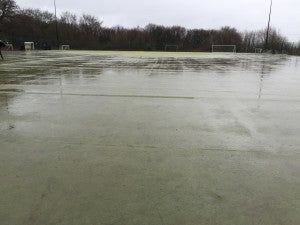Synthetic playing surfaces need attention emerging from winter

"The wet, cold and consistently damp winter conditions are harsh on any surface; they can easily put a natural surface out of use and subsequently increase the usage of a synthetic pitch. This combination can quickly escalate compaction and drainage issues. Problems with drainage will become far more apparent during wetter weather, therefore a pro-active planned approach to maintenance is necessary. By implementing the correct procedures at the right time the pile will be more fluid and the fill more mobile. Keeping the rainwater free flowing will also inhibit moss/algae growth and in turn means a more open, de-compacted surface.
By far the most robust approach to synthetic pitch maintenance is to have strong synergy between 'in-house' techniques and specialist 'outsourced' processes. The daily and weekly element of brushing will greatly improve the look, feel and longevity of the surface. If you don't have the resources of your own 'in-house' grounds staff and equipment, a specialist maintainer can offer this type of weekly service. However, outsourcing will invariably be required for the specialist element. When choosing a supplier make sure their process encompasses de-compaction, extraction of dusts, removal of dirt & detritus and redistribution of the infill - the Replay Revive® process is widely recognised as the industry-leading standard for synthetic maintenance techniques and this can continue to take place during wetter periods.
If the natural draining ability and safety of your surface has become compromised, there are other options available to prevent resurfacing. The Replay Rejuvenation® process uses compressed air to alleviate carpet compaction, remove the contaminated infill and replace this with new clean granulate. The Rejuvenation process will return the surface to an 'as new' condition, adding 5 or more year's useable life at a fraction of the cost of full replacement."
